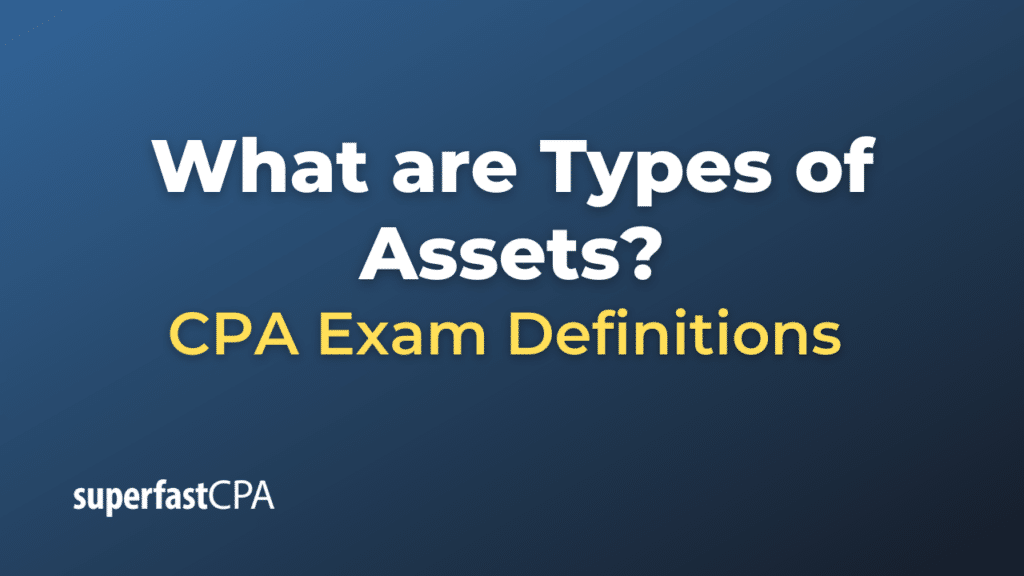Types of Assets
Assets represent resources owned or controlled by an entity that are expected to provide future economic benefits. They are a key component of the balance sheet. Assets can be classified in various ways, depending on their nature, liquidity, life span, and intended use. Here are some common types and classifications of assets:
- Based on Convertibility (Liquidity):
- Current Assets: These are assets that are expected to be converted into cash or used up within one year or the business’s normal operating cycle, whichever is longer. Examples include:
- Cash and Cash Equivalents
- Accounts Receivable
- Inventory
- Prepaid Expenses
- Short-term Investments or Marketable Securities
- Non-Current Assets (Long-term Assets): These are assets that are not expected to be converted into cash or used up within the next year. Examples include:
- Property, Plant, and Equipment (PP&E)
- Long-term Investments
- Intangible Assets (e.g., patents, trademarks)
- Deferred Tax Assets
- Current Assets: These are assets that are expected to be converted into cash or used up within one year or the business’s normal operating cycle, whichever is longer. Examples include:
- Based on Physical Existence:
- Tangible Assets: These have a physical presence and can be seen or touched. Examples include:
- Buildings
- Machinery
- Vehicles
- Inventory
- Intangible Assets: These do not have a physical presence. Examples include:
- Goodwill
- Patents
- Trademarks
- Copyrights
- Brand recognition
- Franchises
- Tangible Assets: These have a physical presence and can be seen or touched. Examples include:
- Based on Usage:
- Operating Assets: These are used in the day-to-day operations of a business. Examples include:
- Inventory
- Accounts Receivable
- Machinery and Equipment used in production
- Non-Operating Assets: These are not necessary for daily business operations but can still generate income. Examples include:
- Investment properties
- Marketable Securities
- Vacant land held for future use or sale
- Operating Assets: These are used in the day-to-day operations of a business. Examples include:
- Based on Life Span:
- Fixed Assets (or Capital Assets) : These are long-term tangible assets used in the operations of a business and are not intended for resale. Examples include:
- Land
- Buildings
- Machinery
- Equipment
- Wasting Assets: These are resources that have a limited life span and reduce in value over time due to usage, decay, or obsolescence. Examples include:
- Mines
- Quarries
- Natural gas wells
- Fixed Assets (or Capital Assets) : These are long-term tangible assets used in the operations of a business and are not intended for resale. Examples include:
- Financial Classification:
- Financial Assets: These represent a contractual claim to cash or another financial asset. Examples include:
- Stocks and Bonds
- Bank deposits
- Derivative contracts
- Financial Assets: These represent a contractual claim to cash or another financial asset. Examples include:
- Other Classifications:
The classification of assets helps organizations maintain a structured record of their resources, manage their assets efficiently, and provide stakeholders with relevant financial information.
Example of Types of Assets
Let’s delve into a hypothetical scenario involving a company and its assets to illustrate these classifications.
Company: GreenFarm Organics, a company involved in organic farming and food production.
1. Based on Convertibility (Liquidity):
- Current Assets:
- Cash and Cash Equivalents: GreenFarm has $20,000 in its business checking account.
- Accounts Receivable: Customers owe GreenFarm $10,000 for products they’ve bought on credit.
- Inventory: GreenFarm has $15,000 worth of organic produce ready for sale.
- Prepaid Expenses : GreenFarm has prepaid $5,000 for a year’s worth of farm insurance.
- Non-Current Assets:
- Property, Plant, and Equipment: GreenFarm owns land, greenhouses, and farming equipment worth $300,000.
2. Based on Physical Existence:
- Tangible Assets:
- Buildings: GreenFarm has greenhouses and storage facilities valued at $100,000.
- Machinery: Farming equipment and trucks worth $50,000.
- Inventory: As mentioned, $15,000 worth of organic produce.
- Intangible Assets:
- GreenFarm owns a trademark for its brand name, valued at $10,000.
3. Based on Usage:
- Operating Assets:
- Inventory: The organic produce ready for sale.
- Accounts Receivable: Money expected from customers.
- Machinery: Equipment used for farming and production.
- Non-Operating Assets:
- GreenFarm has a piece of land, not currently in use, worth $30,000, which it plans to sell or develop in the future.
4. Based on Life Span:
- Fixed Assets:
- Land: GreenFarm owns a large piece of farmland valued at $150,000.
- Buildings and Machinery: As mentioned above.
- Wasting Assets:
- While GreenFarm primarily focuses on agriculture, they have a small patch of forested land for timber. As they harvest the timber, its value decreases.
5. Financial Classification:
- Financial Assets:
- GreenFarm owns shares in a food processing company, valued at $25,000.
6. Other Classifications:
- Biological Assets:
- GreenFarm has a section of dairy cattle worth $40,000. These cattle are maintained for milk production and eventual sale.
Summing up, GreenFarm Organics has a diverse portfolio of assets that play vital roles in its operations, investments, and growth strategies. This example helps illustrate the variety of assets a business might own and how they fit into various classifications.













